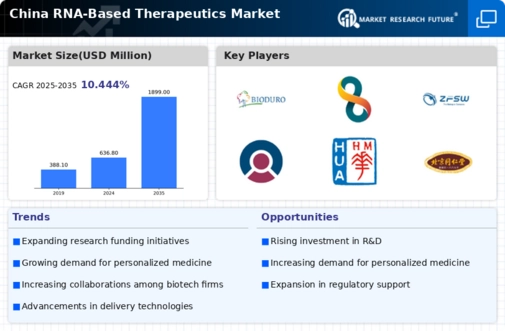Advancements in Delivery Mechanisms
Innovations in delivery systems for RNA-based therapeutics are emerging as a crucial driver in the Chinese market. Effective delivery mechanisms are essential for ensuring that therapeutic agents reach their intended targets within the body. Recent advancements, such as lipid nanoparticles and viral vectors, are enhancing the efficacy of rna based-therapeutics, making them more viable for clinical applications. The ability to deliver these therapies efficiently can significantly impact patient outcomes, thereby increasing their adoption in clinical settings. As the rna based-therapeutics market continues to evolve, the development of novel delivery methods is expected to attract substantial investment, potentially exceeding $1 billion by 2027. This trend indicates a robust future for rna based-therapeutics, as improved delivery systems may lead to higher success rates in treatment.
Rising Prevalence of Genetic Disorders
The increasing incidence of genetic disorders in China is driving the demand for innovative treatment options within the RNA-based therapeutics market. As genetic conditions become more prevalent, healthcare providers and researchers are focusing on developing targeted therapies that can address these specific ailments. The Chinese population, with its unique genetic makeup, presents a significant opportunity for rna based-therapeutics to offer personalized solutions. According to recent estimates, genetic disorders affect approximately 1 in 10 individuals in China, highlighting the urgent need for effective treatments. This growing patient population is likely to propel investments in research and development, thereby enhancing the overall landscape of the rna based-therapeutics market. Furthermore, the government’s commitment to improving healthcare access and outcomes may further stimulate growth in this sector.
Government Support and Funding Initiatives
The Chinese government is actively promoting the development of the RNA-based therapeutics market through various funding initiatives and policy support. Recognizing the potential of biotechnology to transform healthcare, the government has allocated significant resources to support research and development in this field. Initiatives such as the National Key Research and Development Program aim to foster innovation and collaboration among academic institutions and industry players. This support is likely to enhance the capabilities of local companies, enabling them to compete on a global scale. Furthermore, the government’s focus on improving healthcare infrastructure and access may lead to increased market penetration for rna based-therapeutics, potentially resulting in a market growth rate of over 15% annually in the coming years.
Collaboration Between Academia and Industry
The synergy between academic institutions and industry players is becoming increasingly vital for the advancement of the RNA-based therapeutics market in China. Collaborative efforts are fostering innovation, as researchers and companies work together to translate scientific discoveries into viable therapeutic solutions. This partnership is likely to accelerate the development of new rna based-therapeutics, as shared resources and expertise can streamline the research process. Additionally, such collaborations may enhance the commercialization potential of these therapies, making them more accessible to patients. As the rna based-therapeutics market continues to grow, the establishment of strategic alliances is expected to play a crucial role in driving forward the development pipeline, potentially leading to the introduction of several new therapies in the next few years.
Increasing Demand for Preventive Healthcare Solutions
The shift towards preventive healthcare in China is influencing the RNA-based therapeutics market significantly. As the population becomes more health-conscious, there is a growing interest in therapies that can prevent diseases rather than merely treat them. Rna based-therapeutics, with their potential to modulate gene expression and provide preventive solutions, are well-positioned to meet this demand. This trend is likely to encourage investment in research focused on preventive applications, which could lead to the development of innovative therapies aimed at reducing the incidence of chronic diseases. The market for preventive healthcare solutions is projected to grow substantially, with rna based-therapeutics playing a pivotal role in this transformation, potentially capturing a market share of over 20% by 2030.

















Leave a Comment